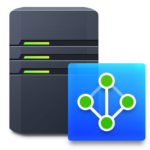Product Properties
| Package name | Synology Directory Server |
| Application name | Synology Directory Server |
| Volume selectable | yes |
| Dependencies | DNS Server |
| Service name | |
| User Home service | no |
| Shared folder | no |
| Home folder | no |
| Licensing | no |
| Hyper Backup support | yes |
| Certificate selection | yes |
| Application Privileges | no |
| Login Portal | no |
| Logging | in app |
| Notifications | yes |
| Firewall ports | 88, 135, 389, 464, 636, 1024, 49300-49320, 3268, 3269 |
| Date | 20 March 2025 |
| Version | 4.15.13 |
| DSM | 7.2.2 |
Functionality
A directory service like Synology Directory Server unites all users, computers, and servers into a single namespace for easy access and maintenance. This is recommended for networks with Windows computers and Synology NASs.
Installation
Install the Synology Directory Server from Package Center.

This adds the Synology Directory Server application to the main menu. This package depends on the DNS Server, which is installed first if it hasn’t been installed.
Configuration
Before configuring the Synology Directory Server, assign a fixed IP address to the LAN interface.
Open the Synology Directory Server app from the main menu. The first screen of the Synology Directory Server setup wizard welcomes you.
The first screen shows the following options. I added the title of the next screen for information purposes only.
- Select a deployment method
- Create a domain
Because this is the first domain controller we create, we choose the first option, which opens the next screen.
- Enter domain information
- Domain name
- Workgroup
- Name: Administrator
- Password
- Confirm password
In this screen, you provide the domain name and administrator password. The Workgroup name is automatically distilled from the domain name, but you can change it if necessary. Both the domain and workgroup names are listed in capital letters.
Create a unique and strong password for the Administrator and store it safely. When you are done, click Next to continue.
- Check preconditions
- Check DSM settings
- Check settings of Synology’s DNS Server
Before giving you the green light, the wizard checks a few settings, including the fixed IP address. When both checks are green, click the Create Domain button to create the domain in DNS and the directory server.
After creating the domain, the wizard shows a pop-up message that the NAS has joined the domain, and it changed DNS Server settings. Click OK. The wizard ends.
For detailed instructions, please refer to Setting Up Synology Directory Server.
Logging and notification
The Synology Directory Server tool’s Log page logs events from the directory server. By default, logging is disabled. Enable logging to start logging events.
There is a single event, a warning, that issues a notification.
Stop and run
Stop and start the Synology Directory Server service from Package Center or SSH.
Uninstall and removal
You can uninstall the Synology Directory Server package with Package Center from the NAS. During the uninstallation, you can retain or remove the domain configuration.
When you have multiple domain controllers on the local network, uninstall the secondary domain controllers before uninstalling the primary domain controller.
To prevent interrupted service, ensure that users can log on to another directory server. To remove LDAP from your network, ensure no user or service relies on Synology Directory Server to function. This includes all servers and computers that previously joined the domain.
Notes
When removing the Synology Directory Server from your local network, consider uninstalling the DNS Server from the NAS unless you plan to use it without the directory.
Thanks for reading
This post is donation-ware, and I made it to help you. Please consider leaving a comment or buying me a coffee if it did. I will be eternally grateful.
Paul Steunebrink / Storage Alchemist
